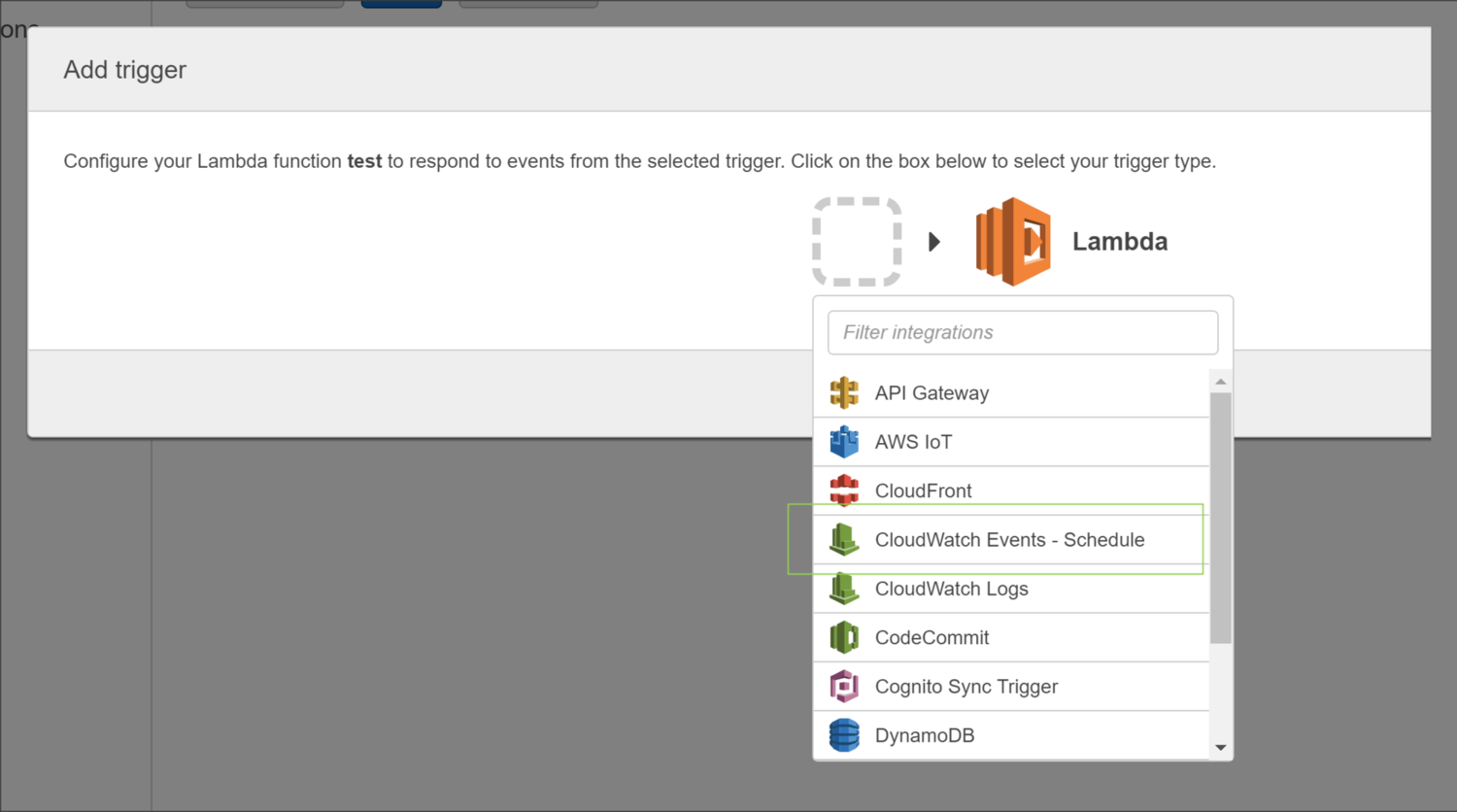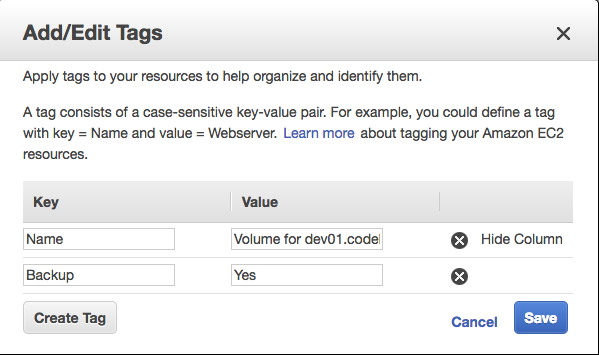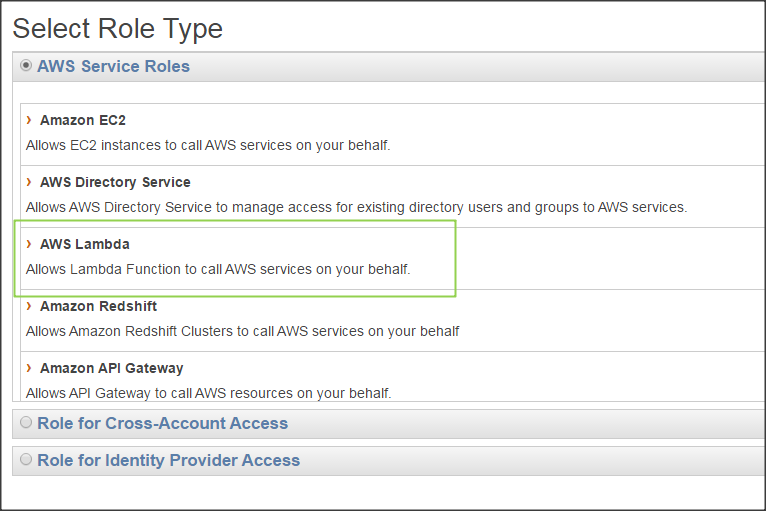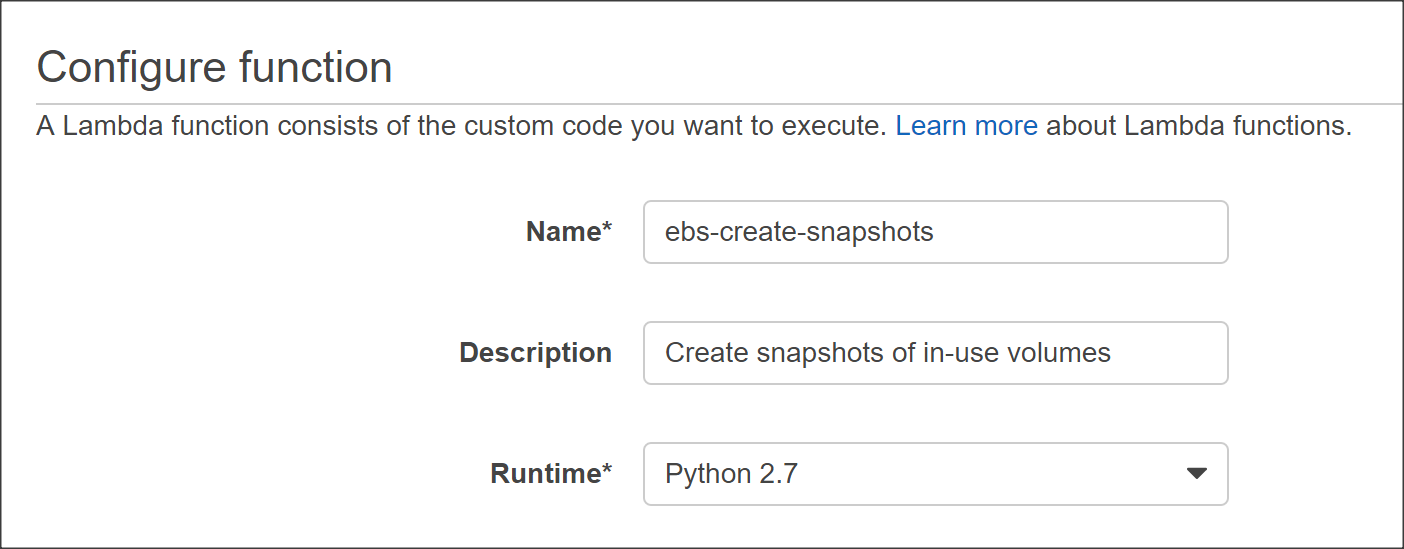Automated EBS Snapshots using AWS Lambda & CloudWatch
Overview
In this post, we'll cover how to automate EBS snapshots for your AWS infrastructure using Lambda and CloudWatch. We'll build a solution that creates nightly snapshots for volumes attached to EC2 instances and deletes any snapshots older than 10 days. This will work across all AWS regions.
Lambda offers the ability to execute "serverless" code which means that AWS will provide the run-time platform for us. It currently supports the following languages: Node.js, Java, C# and Python. We'll be using Python to write our functions in this article.
We'll use a CloudWatch rule to trigger the execution of the Lambda functions based on a cron expression.
Create IAM Role
Before we write any code, we need to create an IAM role that has permissions to do the following:
- Retrieve information about volumes and snapshots from EC2
- Take new snapshots using the CreateSnapshot API call
- Delete snapshots using the DeleteSnapshot API call
- Write logs to CloudWatch for debugging
In the AWS management console, we'll go to IAM > Roles > Create New Role. We name our role "ebs-snapshots-role".
For Role Type, we select AWS Lambda. This will grant the Lambda service permissions to assume the role.
On the next page, we won't select any of the managed policies so move on to Next Step.
Go back to the Roles page and select the newly created role. Under the Permissions tab, you'll find a link to create a custom inline policy.
Paste the JSON below for the policy:
{
"Version": "2012-10-17",
"Statement": [
{
"Effect": "Allow",
"Action": [
"logs:*"
],
"Resource": "arn:aws:logs:*:*:*"
},
{
"Effect": "Allow",
"Action": "ec2:Describe*",
"Resource": "*"
},
{
"Effect": "Allow",
"Action": [
"ec2:CreateSnapshot",
"ec2:DeleteSnapshot",
"ec2:CreateTags",
"ec2:ModifySnapshotAttribute",
"ec2:ResetSnapshotAttribute"
],
"Resource": [
"*"
]
}
]
}
Create Snapshots Function in Lambda
Now, we can move on to writing the code to create snapshots. In the Lambda console, go to Functions > Create a Lambda Function -> Configure function and use the following parameters:
In our code, we'll be using Boto library which is the AWS SDK for Python.
Paste the code below into the code pane:
# Backup all in-use volumes in all regions import boto3 def lambda_handler(event, context):
ec2 = boto3.client('ec2') # Get list of regions
regions = ec2.describe_regions().get('Regions',[] ) # Iterate over regions
for region in regions:
print "Checking region %s " % region['RegionName']
reg=region['RegionName'] # Connect to region
ec2 = boto3.client('ec2', region_name=reg) # Get all in-use volumes in all regions
result = ec2.describe_volumes( Filters=[{'Name': 'status', 'Values': ['in-use']}]) for volume in result['Volumes']:
print "Backing up %s in %s" % (volume['VolumeId'], volume['AvailabilityZone']) # Create snapshot
result = ec2.create_snapshot(VolumeId=volume['VolumeId'],Description='Created by Lambda backup function ebs-snapshots') # Get snapshot resource
ec2resource = boto3.resource('ec2', region_name=reg)
snapshot = ec2resource.Snapshot(result['SnapshotId']) volumename = 'N/A' # Find name tag for volume if it exists
if 'Tags' in volume:
for tags in volume['Tags']:
if tags["Key"] == 'Name':
volumename = tags["Value"] # Add volume name to snapshot for easier identification
snapshot.create_tags(Tags=[{'Key': 'Name','Value': volumename}])
The code will create snapshots for any in-use volumes across all regions. It will also add the name of the volume to the snapshot name tag so it's easier for us to identify whenever we view the list of snapshots.
Next, select the role we created in the Lamba function handler and role section.
The default timeout for Lambda functions is 3 seconds, which is too short for our task. Let's increase the timeout to 1 minute under Advanced Settings. This will give our function enough time to kick off the snapshot process for each volume.
Click Next then Create Function in the review page to finish.
Schedule Trigger as CloudWatch Rule
Navigate to the Triggers tab and click on Add Trigger which brings up the following window:

Selecting CloudWatch Event - Schedule from the dropdown list allows us to configure a rule based on a schedule. It's important to note that the times listed in the cron entry are in UTC.
You'll be prompted to enter a name, description, and schedule for the rule.
It's important to note that the times listed for the cron expression are in UTC. In the example below, we are scheduling the Lambda function to run each weeknight at 11pm UTC.
Testing
We can test our function immediately by click on the Save and Test button in the function page. This will execute the function and show the results in the console at the bottom of the page.

Logging
After verifying that the function runs successfully, we can take a look at the CloudWatch logs by clicking on the link shown in the Log Output section.
You'll notice a Log Group was created with the name /aws/lambda/ebs-create-snapshots. Select the most recent Log Stream to view individual messages:
11:00:19 START RequestId: bb6def8d-f26d-11e6-8983-89eca50275e0 Version: $LATEST
11:00:21 Backing up volume vol-0c0b66f7fd875964a in us-east-2a
11:00:22 END RequestId: bb6def8d-f26d-11e6-8983-89eca50275e0
11:00:22 REPORT RequestId: bb6def8d-f26d-11e6-8983-89eca50275e0 Duration: 3256.15 ms Billed Duration: 3300 ms Memory Size: 128 MB Max Memory Used: 40 MB
Delete Snapshots Function in Lambda
Let's take a look at how we can delete snapshots older than the retention period which we'll say is 10 days.
Before using the code below, you'll want to replace account_id with your AWS account number and adjust retention_days according to your needs.
# Delete snapshots older than retention period import boto3
from botocore.exceptions import ClientError from datetime import datetime,timedelta def delete_snapshot(snapshot_id, reg):
print "Deleting snapshot %s " % (snapshot_id)
try:
ec2resource = boto3.resource('ec2', region_name=reg)
snapshot = ec2resource.Snapshot(snapshot_id)
snapshot.delete()
except ClientError as e:
print "Caught exception: %s" % e return def lambda_handler(event, context): # Get current timestamp in UTC
now = datetime.now() # AWS Account ID
account_id = '' # Define retention period in days
retention_days = 10 # Create EC2 client
ec2 = boto3.client('ec2') # Get list of regions
regions = ec2.describe_regions().get('Regions',[] ) # Iterate over regions
for region in regions:
print "Checking region %s " % region['RegionName']
reg=region['RegionName'] # Connect to region
ec2 = boto3.client('ec2', region_name=reg) # Filtering by snapshot timestamp comparison is not supported
# So we grab all snapshot id's
result = ec2.describe_snapshots( OwnerIds=[account_id] ) for snapshot in result['Snapshots']:
print "Checking snapshot %s which was created on %s" % (snapshot['SnapshotId'],snapshot['StartTime']) # Remove timezone info from snapshot in order for comparison to work below
snapshot_time = snapshot['StartTime'].replace(tzinfo=None) # Subtract snapshot time from now returns a timedelta
# Check if the timedelta is greater than retention days
if (now - snapshot_time) > timedelta(retention_days):
print "Snapshot is older than configured retention of %d days" % (retention_days)
delete_snapshot(snapshot['SnapshotId'], reg)
else:
print "Snapshot is newer than configured retention of %d days so we keep it" % (retention_days)
FAQ
How do I include or exclude certain volumes from the create snapshots function?
The function we wrote for creating snapshots used a filter when calling ec2.describe_volumes that looked for status of in-use:
result = ec2.describe_volumes( Filters=[{'Name': 'status', 'Values': ['in-use']}])
Including Volumes using Tags
We can also create tags on volumes and filter by tag.
Suppose we wanted to backup only the volumes that had a specific tag named "Backup" with a value of "Yes".
First, we create a tag for each volume by right-clicking on the volume and selecting Add/Edit Tags

Next, we modify the script and use the following line for describe_volumes:
result = ec2.describe_volumes( Filters=[{'Name':'tag:Backup', 'Values':['Yes']}] )
Excluding Volumes using Tags
Excluding certain volumes using tags is a bit different. The Filters parameter of describe_volumes is for inclusion only. So we cannot use that to tell the script to exclude specific volumes.
Suppose we wanted to backup all volumes EXCEPT ones with a tag named "Backup" with a value of "No".
First, we create a tag for each volume by right-clicking on the volume and selecting Add/Edit Tags

Next, we modify the script and manually filter the volumes inside the loop:
# Backup all volumes all regions
# Skip those volumes with tag of Backup=No import boto3 def lambda_handler(event, context):
ec2 = boto3.client('ec2') # Get list of regions
regions = ec2.describe_regions().get('Regions',[] ) # Iterate over regions
for region in regions:
print "Checking region %s " % region['RegionName']
reg=region['RegionName'] # Connect to region
ec2 = boto3.client('ec2', region_name=reg) # Get all volumes in all regions
result = ec2.describe_volumes() for volume in result['Volumes']: backup = 'Yes' # Get volume tag of Backup if it exists
for tag in volume['Tags']:
if tag['Key'] == 'Backup':
backup = tag.get('Value') # Skip volume if Backup tag is No
if backup == 'No':
break print "Backing up %s in %s" % (volume['VolumeId'], volume['AvailabilityZone']) # Create snapshot
result = ec2.create_snapshot(VolumeId=volume['VolumeId'],Description='Created by Lambda backup function ebs-snapshots') # Get snapshot resource
ec2resource = boto3.resource('ec2', region_name=reg)
snapshot = ec2resource.Snapshot(result['SnapshotId']) instance_name = 'N/A' # Fetch instance ID
instance_id = volume['Attachments'][0]['InstanceId'] # Get instance object using ID
result = ec2.describe_instances(InstanceIds=[instance_id]) instance = result['Reservations'][0]['Instances'][0] print instance # Find name tag for instance
if 'Tags' in instance:
for tags in instance['Tags']:
if tags["Key"] == 'Name':
instance_name = tags["Value"] # Add volume name to snapshot for easier identification
snapshot.create_tags(Tags=[{'Key': 'Name','Value': instance_name}])
Automated EBS Snapshots using AWS Lambda & CloudWatch的更多相关文章
- 什么是AWS Lambda?——事件驱动的函数执行环境
AWS CTO Werner Vogels在AWS re:Invent 2014大会的第二场主题演讲上公布了两个新服务和一系列新的实例,两个新服务都相当令人瞩目:第一个宣布的新服务是Amazon EC ...
- Qwiklab'实验-API Gateway, AWS Lambda'
title: AWS之Qwiklab subtitle: 2. Qwiklab'实验-API Gateway, AWS Lambda' date: 2018-09-20 17:29:20 --- In ...
- AWS Lambda 借助 Serverless Framework,迅速起飞
前言 微服务架构有别于传统的单体式应用方案,我们可将单体应用拆分成多个核心功能.每个功能都被称为一项服务,可以单独构建和部署,这意味着各项服务在工作时不会互相影响 这种设计理念被进一步应用,就变成了无 ...
- AWS Lambda
AWS Lambda 知识点总结 参考资料:Amazon 名词解释: 事件驱动型计算服务:通过事件来触发的计算服务 Amazon S3存储桶:一项面向Internet的存储服务,可以通过S3 随时在W ...
- [翻译] 比较 Node.js,Python,Java,C# 和 Go 的 AWS Lambda 性能
[翻译] 比较 Node.js,Python,Java,C# 和 Go 的 AWS Lambda 性能 原文: Comparing AWS Lambda performance of Node.js, ...
- How to return plain text from AWS Lambda & API Gateway
With limited experience in AWS Lambda & API Gateway, it's struggling to find the correct way to ...
- [AWS] Lambda by Python
当前统治数据分析的语言还是Python,还是暂时走:Python + GPU的常规路线好了. numba, pyculib (分装了cublas) Ref: 使用 Python 构建 Lambda 函 ...
- 使用AWS Lambda,API Gateway和S3 Storage快速调整图片大小
https://www.obytes.com/blog/2019/image-resizing-on-the-fly-with-aws-lambda,-api-gateway,-and-s3-stor ...
- 本地运行aws lambda credential 配置 (missing credential config error)
参照这篇文章 http://docs.aws.amazon.com/sdk-for-javascript/v2/developer-guide/loading-node-credentials-sha ...
随机推荐
- socket keepalive理解
java socket编程中有个keepalive选项,看到这个选项经常会误解为长连接,不设置则为短连接,实则不然. socket连接建立之后,只要双方均未主动关闭连接,那这个连接就是会一直保持的,就 ...
- shiro三连斩之第二斩(SSM)
在SSM框架中使用shiro.环境 使用idea工具. 最主要的大概是配置文件如何配置吧. 1配置maven依赖 <?xml version="1.0" encoding=& ...
- JS之工厂模式
<!DOCTYPE html> <html lang="en"> <head> <meta charset="UTF-8&quo ...
- Java容器解析系列(9) PrioriyQueue详解
PriorityQueue:优先级队列; 在介绍该类之前,我们需要先了解一种数据结构--堆,在有些书上也直接称之为优先队列: 堆(Heap)是是具有下列性质的完全二叉树:每个结点的值都 >= 其 ...
- Linux集群架构(二)
Linux集群架构(二) 目录 八.LVS DR模式搭建 九.keepalived + LVS 十.扩展 八.LVS DR模式搭建 1.实验环境: 四台机器: client: 10.0.1.50 Di ...
- vim打开txt文件看到^@字符
'\0'是不可见字符,使用vim编辑器查看的文本文件中如果包含'\0'字符,vim会自动将'\0'字符转换为^@字符. 看下面的代码: #include <stdio.h> #includ ...
- 测试使用 Open Live Writer写博客
这里测试文字的显示: 第一段 第二段 第三段 这里测试图片的显示: 这里测试视频的显示: 测试不了,是不是版权问题?
- [.NET] 使用ValidationContext快速进行模型资料的验证
在进行WebAPI功能开发的时候,一般传统的验证资料是否合法的方式,都是透过if/else的方式进行判断若是使用ValidationContext,就可以省去很多自行撰写程式码的工作 要使用Valid ...
- php websocket
php websocket项目开发,推荐使用:Workerman 本片内容使用Workerman实现了简单的及时聊天功能,具体代码如下: <?php // phpinfo(); header(' ...
- VsCode删除多行操作
1.下图是我们的文件 我想要一次性删除"how to delete this line" 所在的所有行,而其他行不删除 操作步骤 鼠标移动到 "how"上面,单 ...






